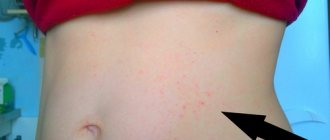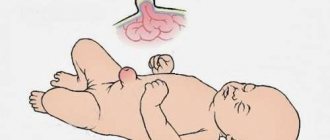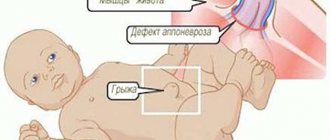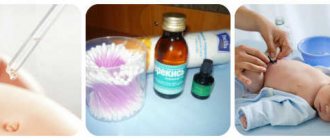Newborns are a population group whose health must be carefully protected. For this purpose, doctors observe newly born children in a specialized medical institution (perinatal centers), and then provide patronage during the first month of life. At the slightest symptoms of the disease, newborns are hospitalized in a hospital. This proves that not only the baby’s parents are interested in his health, but it is also protected by the state. The most common diseases in the first days and weeks of a child’s life are umbilical fungus and omphalitis. They can be diagnosed in the maternity hospital. Most often they are discovered during the first month of life.
What is umbilical fungus?
Umbilical fungus is common in newborns. This disease is common throughout the world among both boys and girls. It is usually noticed by parents when they bathe the baby and treat the umbilical cord. The high incidence of this part of the body in newborns is due to the fact that this place connected mother and child for a long time and contributed to nutrition. In the first minutes of life, the umbilical cord is cut, leaving a stump in its place. Normally, it dries quickly and falls off. But in some cases, the wound takes a long time to heal because it becomes infected. Umbilical fungus is a proliferation of granulation tissue. It develops as often as omphalitis. In some cases, granulations can become infected. This occurs due to the penetration of bacteria into the tissue. Then complications of the disease are possible.
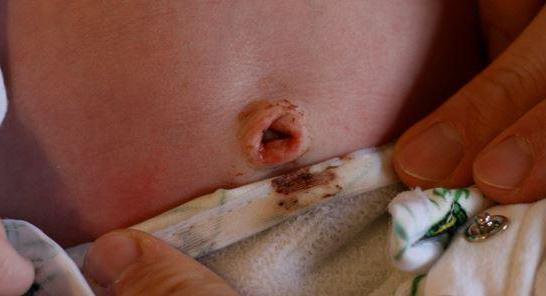
Fungus of the navel in newborns: causes of appearance
The proliferation of granulation tissue is not an infectious process. Rather, it is considered an individual adaptive feature of the organism. There are no specific reasons for the development of fungus. The proliferation of granulations is most often associated with a wide umbilical ring in a baby. After the stump falls away, the free space begins to be filled with fungus. Another reason for its appearance may be a wide umbilical cord. Both of these factors do not relate to pathological conditions, but are characteristics of the body. However, the proliferation of granulation tissue itself is not considered normal. Therefore, navel fungus must be treated. Despite the fact that this disease is considered harmless, its complications are dangerous for the baby’s health.

Causes of granuloma
The etiology of fungus has been studied by medical scientists for a long time. But it is still unclear exactly what causes the proliferation of granulation tissue. It has been revealed that in the presence of a wide umbilical ring, such a formation often forms.

The following children are susceptible to fungus:
- premature;
- with weak immunity;
- overweight.
The main reason for the development of fungus may be insufficient and improper treatment of the umbilical wound. After the stump falls off, the bottom of the navel should be clean.
If there is an unhealed remnant of the process, a granuloma may occur.
Most often, the disease develops in the first months of life. Sometimes the pathological process stops on its own. In this case, fungus causes only a cosmetic defect.
How does umbilical fungus develop?
The development of fungus means the appearance of excess granulation tissue, which begins its growth from the umbilical cord. Predisposing factors include the newborn's high body weight and prematurity. The main reason is a wide umbilical ring. The development of granulation begins after the stump has fallen off. Normally, the umbilical cord remnant falls off quickly. When fungus develops, a small part of it remains. This unhealed cord remnant gives rise to granulation tissue that begins to fill the ring. The process can stop on its own without affecting the baby’s condition. However, this does not always happen. In some cases, granulations completely fill the umbilical ring and begin to extend beyond its limits. This not only leads to a cosmetic defect, but also poses a danger. When an infection occurs, inflammation of the umbilical ring develops - omphalitis. As a result, bacteria can enter the arterial blood and cause sepsis.

What is umbilical fungus and how does it develop?
Navel fungus is not a specific disease and not an infectious disease . Rather, it is an individual feature of the newborn’s body, the reasons for the development of which are not fully understood. A wide umbilical ring often becomes the source of granuloma formation. When the umbilical cord falls off, the resulting cavity is filled with fungus.
The appearance of the granuloma is a mushroom-shaped growth, at the base of which there is a stalk. The fungus occupies the entire area of the umbilical fossa or can extend beyond its boundaries.
Granuloma not only causes aesthetic discomfort, but also often causes negative consequences. Complications develop against the background of secondary infections entering the umbilical ring.
If infection is not attached, fungus proceeds without disturbing the general condition or unpleasant clinical manifestations. Changes in blood parameters are not diagnosed. Complete treatment eliminates granuloma in a short time.
Symptoms of navel fungus
The clinical picture of umbilical fungus depends on the degree of proliferation of granulations. At the initial stage of the disease, there are practically no symptoms. Only a slight increase in the umbilical remnant inside the ring is noticeable. With further growth of granulation tissue, tumor formation is observed. First it fills the umbilical ring and then extends beyond it. As a result, a classic example of fungus is observed - mushroom-like growth of granulations. The formation originates in the umbilical ring and can occupy a significant surface of the anterior abdominal wall. Apart from this symptom, the clinical picture of fungus is weak. In rare cases, there may be an increase in body temperature and a slight deterioration in condition. In newborns, these symptoms are expressed in tearfulness when processing the navel, poor sleep, and refusal to breastfeed. These manifestations should alert parents, as they are often observed during the development of omphalitis.
Causes of navel fungus
At the moment, no scientifically confirmed reasons for the appearance of navel fungus have been found.
Under equal conditions, one baby has fungus, and the other does not. Therefore, it is impossible to say with certainty what exactly caused its formation, but there are some factors that can influence the formation of granuloma:
- Large umbilical ring. After separation of the umbilical cord stump, a lot of space remains, which is covered by granulation tissue.
- Prematurity or high weight. Both conditions are at risk for developing fungus. It is important to maintain proper nutrition, strengthening the immune system.
- Omphalitis (inflammation of the navel). Occurs when any infection (usually staphylococcal) gets into the navel wound. The disease can be both the cause of fungus and its consequence.
Diagnosis of fungus in newborns
Fungus is often confused with other diseases of the umbilical wound. Among them are catarrhal and purulent omphalitis, hernial protrusion, lipoma. When making a diagnosis, it is important to conduct a thorough interview with the baby’s parents. It is necessary to find out how long ago the proliferation of granulation tissue began, whether the fungus is increasing in size, how the child reacts to bathing and treatment of the umbilical area. It is also important to check for other symptoms. A sharp deterioration in the child’s condition often indicates complications that have developed against the background of fungus. If inflammation develops in the umbilical wound, then the following symptoms appear:
- The appearance of serous or purulent discharge.
- Hyperemia and edema.
- Pain when pressing on the fungus area. It is expressed by crying, sudden movement of the baby.
- Increased body temperature.
- Breast refusal.
These symptoms are dangerous for newborns. If they appear, you should immediately seek medical help. Laboratory tests are performed in the hospital. With uncomplicated fungus, no changes are observed in the CBC and TAM. If there are inflammatory phenomena (leukocytosis, acceleration of ESR), this means that omphalitis has developed. In this case, discharge from the umbilical wound is taken for analysis in order to identify the causative agent of inflammation and prescribe treatment. In some cases, fungus can be confused with other formations. If the doctor has doubts, an ultrasound of the soft tissues of the abdomen is performed. Most often, the doctor quickly diagnoses navel fungus in newborns. Photos of this pathology are posted in special medical literature on neonatology. However, parents should not draw conclusions on their own. If granulations appear, you should consult a doctor.
Navel fungus in a newborn: how to treat the disease?
The choice of fungus treatment method depends on the size of the formation and the general condition of the baby. For small granulations that do not tend to grow, observation is recommended. If the fungus increases, then it is necessary to get rid of it. In most cases, for this purpose, granulations are cauterized with nitrogen and silver lapis. If there is navel fungus in newborns, treatment (surgery) is carried out in the pediatric surgery department. The child must be hospitalized and examined before the intervention. The operation consists of removing granulation tissue and washing the umbilical ring with antibiotic solutions.
How to treat the disease
Treatment of navel fungus in newborns is not carried out as such.
. The baby’s general condition returns to normal on its own without taking additional measures, and the fungus heals after a short time.
Despite the ability to self-stop, granuloma sometimes requires specific therapy. Therefore, you should not miss the first warning symptoms, but you should consult a doctor if:
- the occurrence of edema;
- redness around the umbilical ring;
- presence of exudate.
Every mother can treat fungus independently at home. In combination with the use of medications, it is necessary to maintain daily hygiene of the affected area. It is recommended to put on and remove the diaper carefully, avoiding injury to the granulosa tissue. is described in the article at the link.
For a speedy recovery, the following drugs are used:
| Name, release form | Dosage, method of application | Contraindications | Side effects | Average price in rub. |
| HYDROGEN PEROXIDE solution | Apply 2-3 drops after bath | Hypersensitivity | Allergic reaction | 3-10 |
| BRILLIANT GREEN solution | Treat granuloma after a bath | Hypersensitivity | Allergic reaction | 5-14 |
| IODINE solution | Treat after bath | Hypersensitivity | Allergic reaction | 10-15 |
| CHLOROPHYLLIPTE, solution | Treat the navel several times a day | Hypersensitivity | Allergic reaction | 60-100 |
- Hydrogen peroxide is an environmentally friendly substance, which makes it available for use by both adults and children, including newborns. The drug has a disinfectant effect, preventing infection from entering the wound.
- DIAMOND GREEN solution is used for many pathologies of the skin, including open wounds of the epidermis, abrasions and cuts. For fungus, the medicine cannot be used together with other disinfectant preparations, which contain iodine, alkalis and chlorine.
- IODINE has a disinfecting effect. Helps reduce the intensity of the inflammatory process and eventually stop it completely. In addition to allergies to substances, prohibited use includes trophic and diabetic ulcers on the skin.
- CHLOROPHILLIPT is used even when local antibiotic drugs are ineffective, to which staphylococci may be resistant. Approved for use by both adults and newborns.
